A Renaissance Reimagined: EIC Kenneth Goh Falls Under Cartier's Spell In Florence
Escape to a land where the sunsets are magical, the wine is overflowing and the jewels are crafted into works of pure art. Kenneth Goh is whisked off to Florence and falls under the spell of Cartier.
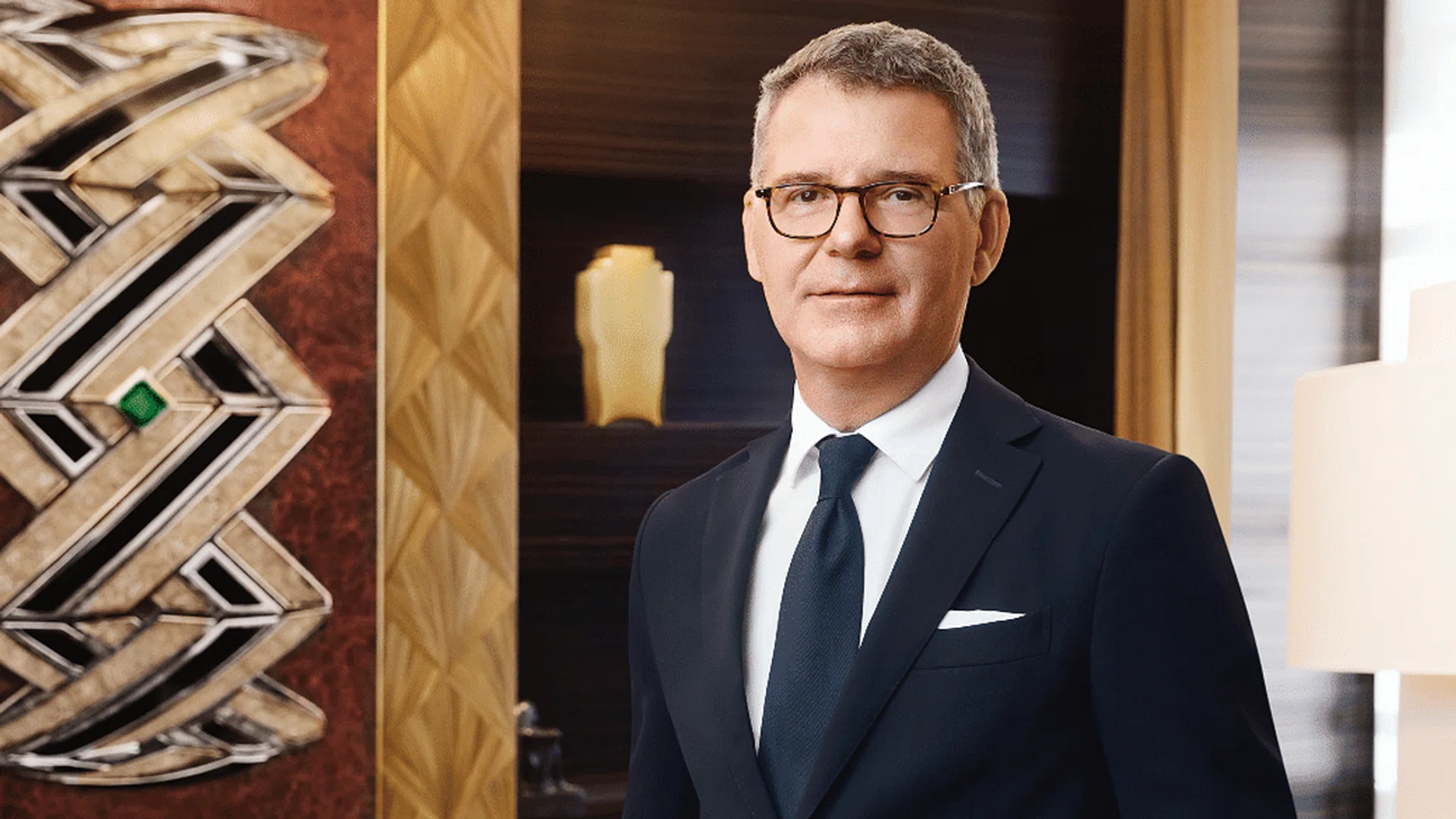
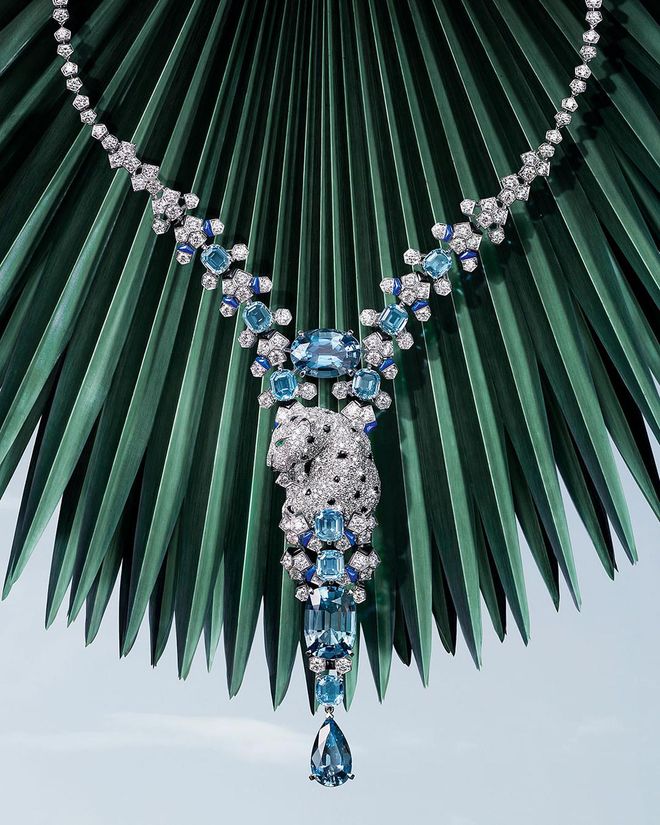
Panthère Givrée necklace in white gold with aquamarines, lapis lazuli, onyx, emerald and diamonds.
The act of seduction, and the acts of romance, has never played better than in the hands of Cartier. If Cartier was alive today, he would be the ideal lover, companion, husband and bon vivant. Let’s first set the scene in Italy—a land of plenty. In his latest mise en scène, where high jewellery is at stake, he entices you by whisking you away to the sunny shores of Florence—vibrant in culture, food, wine and heritage. In the summer months when the Tuscan air is rich with the sound of birds and the smell of ripening vines, the stunning Villa Reale di Marlia sets the scene for high jewellery. Think impressive 17th century architecture set against verdant stretches of nature and flora. A palace of terracotta walls and green shutters amidst the beautiful and lush hills of Tuscany. As you amble the grounds, your heels clipping the cobblestones and echoing in the cool, dark grotto, it feels as if you’ve stumbled upon Cartier’s best artisanal crafts with the poetic sight of musicians and dancers celebrating your finds.
Related article: Cartier’s New Bejewelled Jungle Is Full Of Surreal Animals
And there lunch awaits, with four enchanting maidens, dressed in pistachio green gowns, playing classical music as you nibble on the freshest greens and light poached salmon at your private canopy beside a sculptured pond. Satiated—you proceed to the main stage of seduction—the high jewels. Within the walls of the stunning villa, this Renaissance palazzo, that once attracted princesses, emperors, artists and VIP’s from all over the world, is now privately open for you to ogle wide- eyed at the splendours of the world’s best jewels and gems.
Called Le Voyage Recommencé, this exquisite collection of high jewellery pieces reimagined the rules for geometrical relationships, creating highly graphic combinations of universal figures. Think extreme stylisations of traditional, decorative forms. Imagine grand sculptured pieces with generous volumes. Everything heightened with the dazzling effects of 3D jewel-setting that Jeanne Toussaint (Cartier’s famed director of Fine Jewellery in the ’30s) loved so dearly. Precious stones are mixed in colourways that reflect flora and fauna in such intense tones, they are simply brilliant. By adding a few singular touches to the emblematic Tutti Frutti style, to the geometrical designs of the Islamic arts, or to Chinese decorations, the Maison’ designers revisit the style sensibilities for other worlds and cultures that has always been a source of inspiration for Cartier. The collection pushes the boundaries of creativity through more than 80 pieces (with more than 350 pieces to view in totality). Via geometry, abstraction, volume and architecture, inspirations from nature and the world’s great cultures all come together to embrace the closest parts of your body: to caress your neck, to envelope your ears, to grace your fingers and wrists and delve deep into your cleavage.
Suitably romanced? Perhaps you need to take a breather in the lemon garden, out in the fields of the villa with a short game of Pétanque while enjoying your berry sorbet? Take respite from the splendours of Cartier—because we all know that you can’t wait to go back for more. That is seduction at its best.
But alas, work beckons, reality sets in and I put back on my editor’s hat to sit with Pierre Rainero, image, style and heritage director of Cartier to talk about Le Voyage Recommencé.

Girih necklace in platinum with emeralds, turquoise and diamonds.
As someone responsible for the Maison’s archives, what are some of your biggest challenges, as well as the greatest highlights?
Heritage is more than the archives. Archives is one part, but as far as archives are concerned, the traditional challenges you have is the protection of the contents. But this started a long time ago. Already in the Seventies, we went into a process of microfilming. And of course, for the last 25 years, we have entered into digitalisation. So now everything is computerised.
Tell us about Le Voyage Recommencé. What is the ethos and inspiration behind this collection?
Everything started with our intention to display and to share our contemporary vision in terms of design. And we have a more advanced evolution in terms of the creation of new shapes and new association of colours to show our contemporary vision. And we felt that it was even more visible if we took the existing fields of expression or traditional fields of expression, like the inspiration we take for instance, from other cultures, other civilisations, or the importance of geometry or the importance of nature and things.
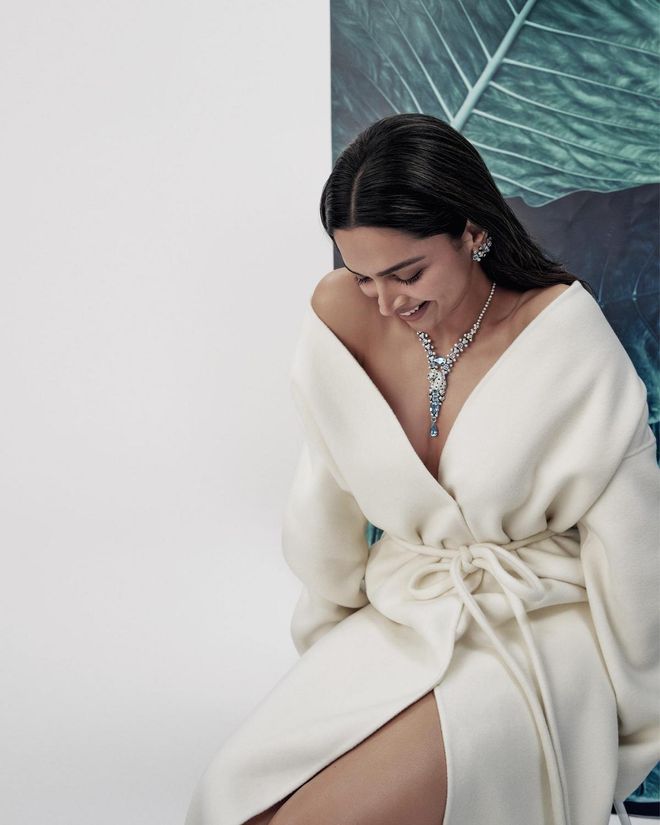
Deepika Padukone wears the Panthère Givrée necklace and matching earrings.
There are over 80 pieces in Le Voyage Recommencé. What are some of the most outstanding pieces in this collection from a design and technical standpoint, and why? Which is your personal favourite piece from the collection?
I think of two pieces that immediately come to mind and that illustrate very well at the same time, the specific approach of this collection and the Cartier spirit. For instance, the Girih. This piece is inspired by Islamic art, but the idea was not to go to the archives to see a previous Islamic art-inspired Cartier piece. It’s a new proposal, a new thing. So, of course, you recognise the blue and green that resonates with Cartier. You recognise the geometry that comes from Islamic art, some combinations, but the result is totally new and nothing to do with the previous pieces coming from that kind of inspiration. So, I think this is a good example of a collection.
And there’s another piece I like also because it’s very emblematic. It’s Distrysia. I think it shows many Cartier specificities. First, the choice of a stone itself I think is a particularity at Cartier—to go for stones that are totally unusual. And in the colour, because the colour makes it not the most precious diamond, but it makes it very interesting, very different. The second point is it also shows that in our philosophy, the stones lead the design. So, the necklace is entirely linked to a specific shape— something asymmetrical. We know that harmony can come from something that is not symmetrical and this is also something interesting, and it also shows many principles that are essential to Cartier. For instance, the idea of perfect fluidity of a piece that is achieved with many different little parts assembled together. And then these little shapes give an illusion of Egyptian scarab wings that were used in the past in our designs. And the mix of colours—to clash lapis lazuli with diamonds. The result is a totally new design: something that never existed before yet keeps the philosophy and the principles of Cartier.
Related article: Cartier Names Deepika Padukone As Its Newest Brand Ambassador

Deepika Padukone wears the Pandjara necklace in platinum with rose gold, a fancy deep brown yellow diamond, onyx, and brown and white diamonds.
When you talk about the weight of a piece of jewellery, do people appreciate if it’s lighter or heavier?
This is a very interesting point because I think there should be a right balance. It shouldn’t be an inconvenience. It shouldn’t be too heavy, but when it’s light, it’s a problem because people don’t feel it. And I think there’s a pleasure in feeling the presence, a certain weight.
We know that we cannot go beyond a certain weight. Of course, there are pieces, by essence, that cannot be heavy. Like earrings. We have some weight, and the earrings are very technical, even in terms of the orientation and the way the motif is oriented with the clasp. So it’s a precise question of degrees. And then again, constraint might be an opportunity because the movement leads you to invent different things. And for brooches, we should be very careful in their weight too, because if they’re too heavy, they can only be on a tie on a man or on a very thick jacket. The temptation with a brooch is there’s no constraint in terms of fitting your neck or your wrist or your finger. But weight plays a huge part. So you have to be reasonable and to take that into consideration. Brooches are probably one of the strongest statements for the wearer because of that object value. It’s something you wear to show who you are. That’s why so many brooches are using animal inspirations or things like that because it’s a way of being associated with what the animal conveys and when you have the colours, you have everything.
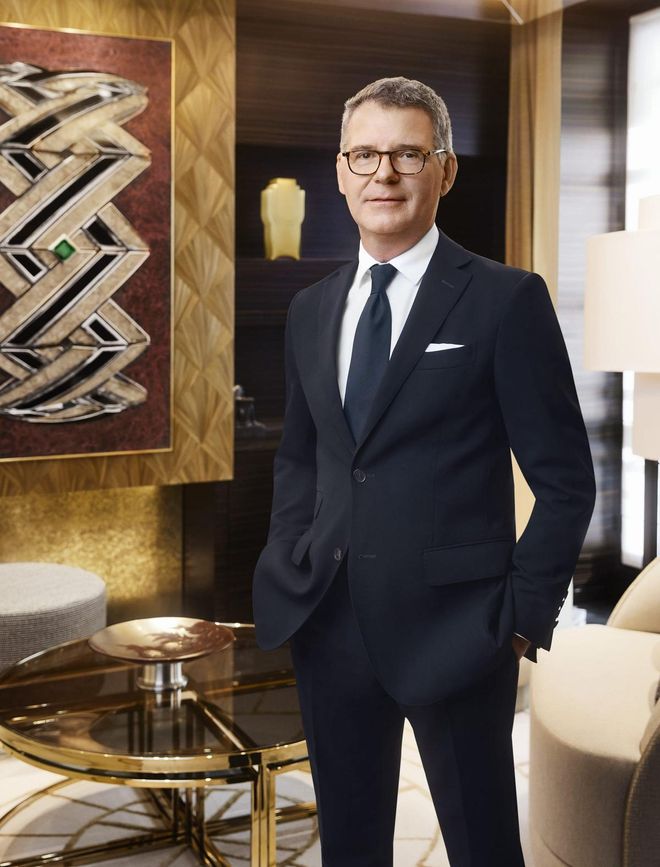
Pierre Rainero, image, style and heritage director of Cartier.
Tell us about some of the exceptional or unusual gemstones in this collection, such as the grey violet diamond in the Ondule ring? How do you approach gemstone selection at Cartier?
We have different parameters. Of course we are jewellers. So jewellers work with the most exquisite stones. And there are stones that are always requested by our designers and by us, because we love beautiful emeralds, beautiful rubies, beautiful diamonds... and these are classics. And then have the fancy brown diamond. In this, you have, according to the spirit of a collection, the request for stones that could better illustrate the theme of a collection. So that’s why when the theme is chosen, the hunt for stones can last for months. We start the designs when the stones are gathered. We have to have a certain number of pieces at different levels of pricing. We’re commercial people with sales staff; we say, okay, we would need more bracelets this year, more rings or more necklaces, short necklaces, long necklaces. So the designers have to play with that and when we choose the stones, the value of the stones is a part of the decision. When we pick up the stones, we have very interesting meetings with the designer where all the stones are put on the table; there’s no camera and, each of them is on paper. You have an indication of what they are, the carats and the price. The designers have in mind their objectives and when they choose the stones and when they choose to mix some of the stones beforehand, they know about the construction and approximately to which bracket it will lead. And that’s how a collection is built. So, all the parameters are taken into account.
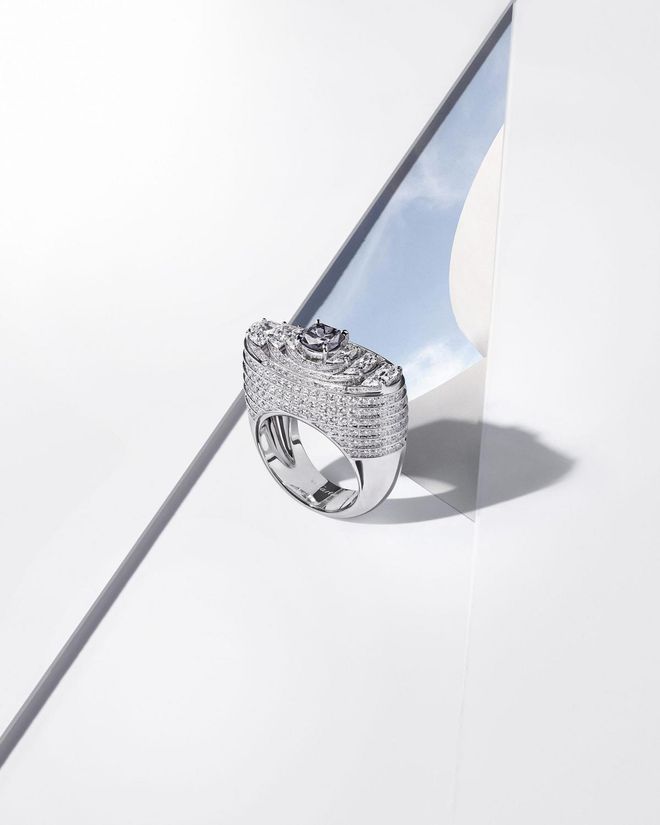
The dramatic Ondule ring in white gold with a fancy grey violet diamond and white diamonds.
So, are there certain kinds of pieces or periods that people always ask for?
You know, in a way, Cartier is a victim of its popularity. Some of the periods are very well-known, like the Garland style, the beginning of the 20th century, and the Art Deco period. And within the Art Deco period, the geometrical ones, the Chinese-inspired ones or the Egyptian ones.
If anything, with Cartier tradition, people’s desires areverymuch informedbypopcultureandbytrends, because you would gravitate to a piece based on what you’re seeing around you, subliminally, without you even really thinking about it.
To your point of yellow gold, more and more people are requesting for pieces from the Seventies that are made of yellow gold. That might be a sign. So traditionally, the requests we receive from the department is an indicator of the interest of a client. The panther from the Eighties is also a very interesting era. And many of them are in yellow gold.
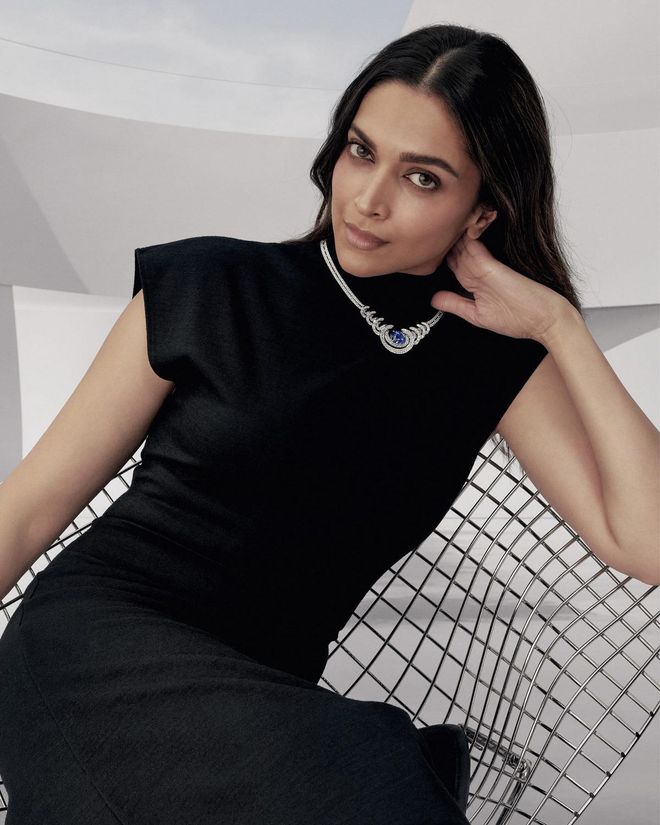
Deepika Padukone wears the Sama necklace in white gold with sapphire and diamonds.
Related article: Cartier’s Iconic Love Bracelet Now Comes In Necklace Form
Who is the woman wearing a Cartier high jewellery piece? When Cartier designs for her, what must her jewellery be able to do for her wardrobe and lifestyle beyond being a beautiful and wearable piece of art?
First of all, I was afraid of the beginning of your question because I don’t think there’s one woman. It’s not linked to that and I’m always surprised by the choices made by certain women because you never know who will buy the piece you propose. And the lesson I get from that is that jewellery is not something you plan. Jewellery talks to your heart: ‘Oh, I like it.’ And you don’t have a reason behind why. It talks to you and it helps the woman to know herself better, probably through the emotion she will feel. And that’s why I think then when this emotion is there, when it is the moment you choose to wear it, it is so important to her that everything will follow. If the will is there, everything will follow.